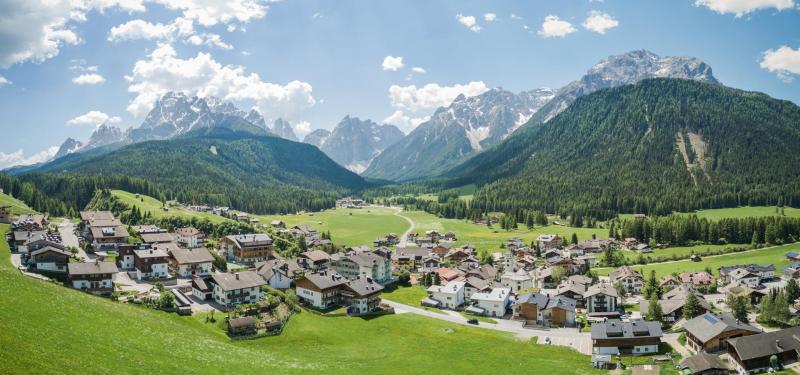The Sexten Dolomites are not only famed for their Three Peaks – the giants that form the Sexten sundial are a wonderful sight too. In this mountain portrait, our blogger Sabine presents this natural phenomenon in the Upper Puster Valley.
The Sexten sundial
The Three Peaks – the Drei Zinnen or Tre Cime – are certainly not the only summits that ensure the Upper Puster Valley is a popular destination for excursions and hikes! Here, in the very eastern part of South Tyrol, there are plenty of 3,000-metre peaks – and they make a picturesque backdrop to the villages, such as the tranquil Sexten. In today’s mountain portrait I want to introduce you to five Dolomite peaks at whose foot is Sexten, a municipality of almost 2,000 inhabitants. These summits – the Einserkofel, Neunerkofel, Zehnerkofel (also called the Sextner Rotwand), Elferkofel and Zwölferkofel all form a unique natural phenomenon – the famous stone sundial.
The peaks of the Sexten sundial
The
Sexten Dolomites stand on the north-eastern boundary of the World Heritage Site of the Dolomites.
The Sexten sundial refers to a series of peaks whose names correspond exactly to the course of the sun. The lowest peak of the Sexten sundial is the Neuner, 2,585 metres in height and characterised by different layers of sediment that can even be seen from a distance. It is followed by the Einserkofel (2,698 m) – from which, in 2007, some 60,000 cubic metres of rock plunged into the valley – and the Zehner (2,965 m), considered to be the eastern cornerstone of the Sexten Dolomites and first climbed in 1878 by Michel Innerkofler and Roland von Eötvös. At 3,068 metres, the Elferkofel is the highest peak in the sundial and one that can look back on an eventful past: this mountain chain was the scene of numerous battles between Italian and Austrian troops in the First World War, and relics of that era can still be found. The Zwölfer (2,917 m) was first climbed in 1874 by the South Tyrolean Hans Innerkofler; it is located on the border with the neighbouring community of Belluno, very close to the Three Peaks.
My personal favourite hike
The famous “Trail of the Alpini”, now a popular via ferrata (fixed-rope route), ran through the range. There are numerous climbing and hiking routes here so, if you are on holiday in the mountains, this part of the Puster Valley is the right place for you!
What about a hike from the Rotwandwiesen to the Kreuzberg Pass? This is a beautiful, six-kilometre high-altitude trail that follows old paths used during the war; from here can be seen the Carnic Ridge and the ice-covered peaks of the Riesenferner Group. The tour is relatively easy, with few ups and downs. Starting at Moos, you head for the valley station of the cable car that takes you up to the Rotwandwiesen. Path no. 15 leads through a light forest, then along under the bizarre rock formations of the Sexten Rotwand, the Neunerkofel and the Arzalpenkopf; this section in particular bears traces of its wartime past. Next comes a short descent through the forest, then via Path no. 13 A to the “Signaue” and finally via the Sexten circular tour (No. 1) back to your starting point.
So how does this stone sundial actually work?
Of course it’s not my intention to deny you the most important information of all! ;-) When observed from Bad Moos at the winter solstice, the course of the sun coincides with the order of the Dolomite peaks. The best place to see this natural phenomenon is from the main road between Moos and the Haus Sexten: at noon the sun will be shining above the Zwölfer, at 1 p.m. above the Einser, and so on.
It is assumed that the Romans began to count the daylight hours from sunrise on – thus the sixth hour (sexta hora in Latin) corresponds to today’s noon or twelfth hour, as indicated by the Zwölferkofel (“twelver peak”). Cultural historians therefore presume that the origin of the name Sexten may derive from this “sexta hora”.

The Sexten sundial is certainly a unique natural phenomenon – not for nothing is it regarded as the emblem of Sexten. Would you too like to view this marvel? Then check out the offers of our
private landlords nearby – where you can enjoy a good time in every sense! :-)
Yours
from the heart, Sabine